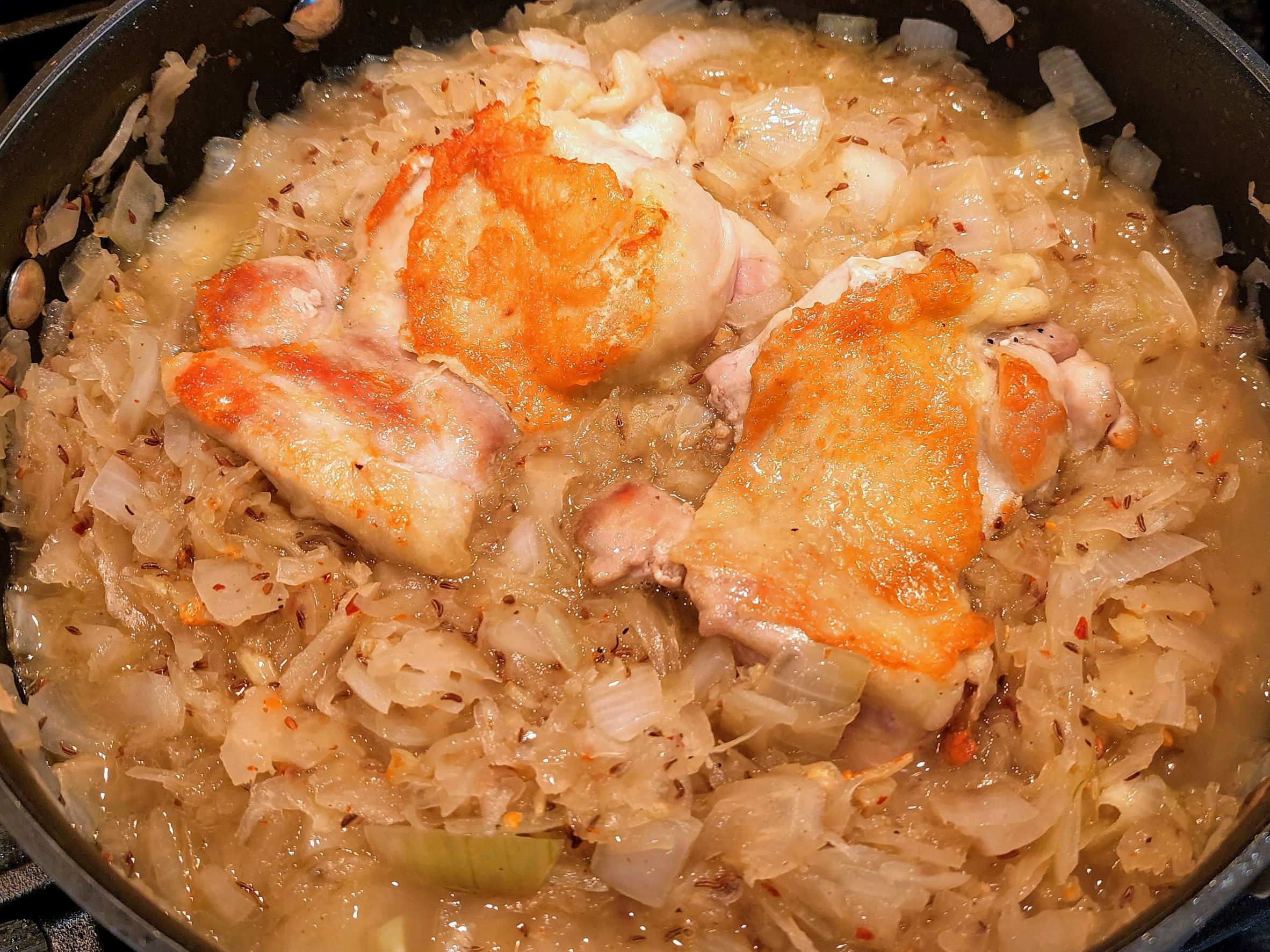 Our friends at Wikipedia tell us that Podvarak is ” is a Serbian dish made of finely chopped sauerkraut, onions and meat, usually pork roast or chicken, which are combined and baked in an oven,” which is the sort of description that explains why you’ve never heard of it…and why you’re not suddenly overcome with the desire to try some. To me, it conjures up memories of the amazing dish that my friend Audrey used to cook up on a regular basis and the inevitability of the rest of the Aquino clan clamoring for the recipe to try their own hand at it.
Our friends at Wikipedia tell us that Podvarak is ” is a Serbian dish made of finely chopped sauerkraut, onions and meat, usually pork roast or chicken, which are combined and baked in an oven,” which is the sort of description that explains why you’ve never heard of it…and why you’re not suddenly overcome with the desire to try some. To me, it conjures up memories of the amazing dish that my friend Audrey used to cook up on a regular basis and the inevitability of the rest of the Aquino clan clamoring for the recipe to try their own hand at it.
It’s one of those dishes that transcends its components to become something wonderful on its own. I strongly suspect that it’s one of the dishes that have a strong element of umami, the taste added to the litany of sweet, sour, salty, and bitter proposed by Kikunae Ikeda proposed in 1908. Unami, which is hard to pin down, is a “pleasant savory taste,” which food scientists weren’t quite sure whether to admit to being an actual flavor until late in the century, but I’m pretty certain that its the flavor that takes stews and soups from good to great. The sort of edge that a beautifully crafted savory broth has makes you cock your head to one side and savor the moment.
On the other hand, I like sauerkraut just fine.

The Cooking Of Vienna’s Empire – Foods Of The World (1968)
Contents: Chapter I In the Days of the Old Empire. Chapter II Austrian Cooking Today. Chapter III In Austria’s Provinces. Chapter IV The Food of Hungary. Chapter V The Influence of Czechoslovakia. VI The Cooking of Yugoslavia. VII The Pastry Paradise.
Audrey found her recipe for Podvarak in a Time-Life Foods of the World cookbook, though I’m not sure which one, back in the 1970s. Audrey, born in California, had lived in Iran for a number of years before returning to the US with my friend Mike, an Italian/Jewish/American boy who smuggled her out of the middle east, so she was no stranger to world flavors. Were she around, she’d probably tell you she taught me how to cook, and I’ll agree that she and Mike expanded my worldview on food and many other things considerably, but well, let’s just say that I got my first omelet pan when I was in elementary school.
A little Googling makes it seem likely that her original recipe came out of The Cooking Of Vienna’s Empire (1968), but all of Audrey’s recipes got quickly marked up with notes on how she’d expanded the dish to suit her.
I may have a copy of her notes somewhere. I remember tussling with her neighbor Karen after Audrey died over the cookbooks…but I think Karen won. I may have gotten photocopies though. At the time, I thought recipes were really important, these days, less so. In fact, I think recipes very nearly serve to convince people they can’t cook, and it can take a long time to get over that.
A few days ago, when my gal asked me to cook up some chicken thighs we had frozen away, a little light popped on in my head saying that this would be a great time to make up a batch of Podvarak. I haven’t made it since Audrey died, and that was decades ago, but I remembered the steps, standing at their kitchen sink looking out at the Ramapo Mountains to the north as I rinsed the sauerkraut and browned up the chicken. It’s dead easy, though this version may not match the one in the book, I’m pretty sure it would have passed Audrey’s muster.
Podvarak
- 4 chicken thighs (skin on)
- 1 medium to large onion, chopped
- 1 package sauerkraut (12oz or so) I used the fresh stuff from the meat case, but canned would probably be fine.
- 3 cloves garlic, minced
- 1/2 teaspoon caraway seeds
- 1 can chicken stock
- Crushed Red Pepper – a dash or a few, depending on you
- Salt, Pepper, Olive oil as needed
Fill a large pot with water dump the sauerkraut in. We’ll return to this in a bit.
Now, brown the chicken on both sides over medium heat in a large skillet with a splash of olive oil for about 5 minutes on each side, but be sure you get some nice color. Remove the chicken (it’s not cooked through yet, btw), and add the garlic to the pan to cook. Give the garlic a few minutes head start until it starts to soften up, then add the onions and cook them for five minutes, until they soften up too.
Strain the sauerkraut from the water, and press out excess water from it. This isn’t all that critical, but you don’t want to swamp the onions just yet. Add to the onions and garlic. Add the caraway seeds, cook for five minutes and then add the chicken stock. Add salt at this point if it needs it. Grind some pepper in and give it a few shakes of the crushed red pepper for zest.
Now, take the chicken and mush it into the mix, leaving the skin side uncovered. Cover with a lid and simmer for half an hour.
That’s pretty much it. French bread is always a good idea, as there will be some pretty tasty broth in the pan, and a Sauvignon Blanc went nicely with it. Beer works too.
Like many things, this gets better if made the day before and reheated.
Note: My friend Myron, who is as I recall of Yugoslavian extraction, says his mom used to make this all the time, but no caraway seeds. I’m not surprised, but I’m still voting for the caraway.
Myron also sent me his mother’s recipe, written in Croatian, and I ran it through Google Translate to see what came out. Enough so that the idea is pretty clear, and I can just hear his mother saying not to bother adding fat because the meat has enough already.
Myron’s Mom’s Podvarak
- 1 kg of dry meat (or can be used 2kg pork or p iletine with bones)
- 2 head cabbage (about 2kg)
- 2 an onion
- 1 head of garlic
- 3 teaspoons red pepper
- 1-2 teaspoons of vegeta
- 1 bay leaf
- 20-odd grains of black pepper
- some oil
- pinch of salt
- 200g bacon, izsjecena (to taste)
Wash sauerkraut under cold water and cut into thin ga. Put a little oil in a pot and put the cabbage is cooked. Add finely chopped onion, garlic, a little red pepper. If desired, you can put one bay leaf. If you do not brine the cabbage salty enough. Pour in water and add the peppercorns. Cook until cabbage is not omekani and while almost all liquid has evaporated.
Meanwhile, pork or chicken, nasoliti, cut the parts and put in the pan to bake. Do not put grease than just add some water, because Why would they let their fat meat. When it is cooked, and ruddy skin, remove the meat, add the bacon and izdinstajte.
In saft and fat that is left from the roasting and bacon agree stewed cabbage, and then over roasted meat.
Put it all in the oven in the oven for about 35 minutes.
